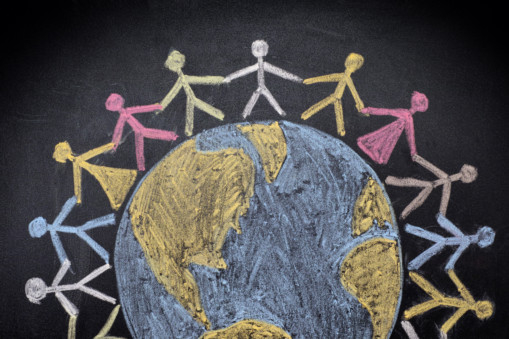
“A‘black girl’. How weird is that?” I laughed. I’m met with silence from my mum’s side of the dinner table.
“It’s not weird. It’s what you are.”
Like one million other people in the UK, I’m mixed race. Up until I was a teenager, I’d never considered I could be anything else.
It’s year 8 – I’m probably about 12 or 13. The day hasn’t been hugely out of the ordinary, but something had happened earlier that made me feel a bit odd. For the first time in my life, I’ve been referred to as “black”.
Sitting down to dinner that night, as a unit, my family look like a sort of Pantone colour chart of milky beige to deep brown; my mum’s black, my dad’s white, and me and my siblings are various shades of in-between – who’s darkest generally depends on who had been playing in the sun the longest. We exemplify the sort of image of modern Britain that was particularly prevalent during the run-up to the London Olympics. Despite the day’s confusion, early-adolescent me knows one thing for sure: while I am proud of my ethnicity, and being half black, I am not black, I am mixed race. Both parts are equally important to my identity. Mum is visibly getting a bit agitated now. “Most people don’t see that. Above all, you’re black.”
Raising a family in the 1990s, when interracial relationships were rarer, my parents were careful to instil a clear sense of what it meant to be mixed. I can’t remember a time when I didn’t fully understand my culture(s), and I grew up feeling incredibly confident in my blackness and my whiteness.
But a couple of years earlier, moving from a diverse primary school in London to a majority-white secondary school in Hertfordshire, I had started to sense that the way I perceived my racial identity, and the way others did, didn’t necessarily match up. I didn’t fit in, and routines shifted accordingly: I started setting an alarm on my bubblegum-pink Motorola at 5am so I could flat-press and coil my hair into gentle waves in time for school, accompanied by lashings of grease. I’d also stopped wearing the folded bandanas, side-ponytails and diamante-encrusted handbags that got me called a “chav” by classmates. But this “black” thing, in all its starkness, felt more striking. In some ways, I think I didn’t feel like I could qualify for “black” status. But it happened more throughout my teenage years, and I got used to it.
Ten years on, towards the end of my degree, I learned that sociologists call this “hypodescent”; in line with the logic that dictated the one-drop rule during slavery in the US, when you’re a mixed-race ethnic minority, your minority heritage often becomes more socially important. In many ways, it’s a natural element of human thinking: the thing that marks you as different is more notable than the part of you that is the same as everyone else. Mixed people are often categorised this way – it’s what makes Barack Obama the “first black president”, and what makes Tiger Woods a black golfer, despite his self-proclaimed status as “Cablinasian”.
As I’ve grown older and entered more and more environments where there are fewer faces like mine around, the case for self-defining as “black” has become clearer. At university, I found myself part of a tiny minority and felt more marked out by my blackness. Suddenly, blackness actually felt hugely important, partly as a means of gaining solidarity. There weren’t enough people of colour around for me to clarify that by saying, “actually I’m only half …” The common ground was more significant.
This isn’t to erase mixedness entirely – it’s important to acknowledge that as a mixed person I undoubtedly benefit from some privileges. Take mainstream beauty standards. Compared to many people with two black parents, my natural curls are looser, my skin tone is lighter, and my features more “typically” European. Whether or not acquaintances understand that my mixedness plays a role in what prompts them to tell me that I’m “pretty for a black girl” or that I have “good hair” is unclear, however the privilege pervades nonetheless.
It feels important to interrogate the concept of mixedness. We are the fastest growing ethnic category, but as we become more common, the debates surrounding the social experience of mixed-race people seem in many ways not to have moved beyond the concept of being “caught in-between”. Between two cultures, two colours, two languages, and so on. But sometimes I don’t feel caught in-between at all; often it’s quite the opposite. Yes, mixedness feels rich, full and multifaceted – but I’m also now aware that not everyone sees it, and that for many, blackness is still my “definer”, my marker of difference. I am black. But I’m also mixed, and that’s not a contradiction.
Pervasive negative ideas, perceptions and values surrounding race can, of course, be internalised — the inner depths of our subconsciouses are not immune to absorbing harmful racial stereotypes. And they affect me, too, and how I perceive myself. They may have played a role in my teenage reluctance to be seen as “fully”, or “only”, black. Although I could describe my heritage as “half-and-half”, the social weightings aren’t necessarily so — I have had to teach myself to love my blackness in a way that I never grappled with my “English side”. But perhaps that’s what makes owning the word “black” all the more significant, and all the more liberating.
–Guardian News & Media Ltd
Micha Frazer-Carroll is founder and editor-in-chief of Blueprint, a magazine that focuses on mental health.












